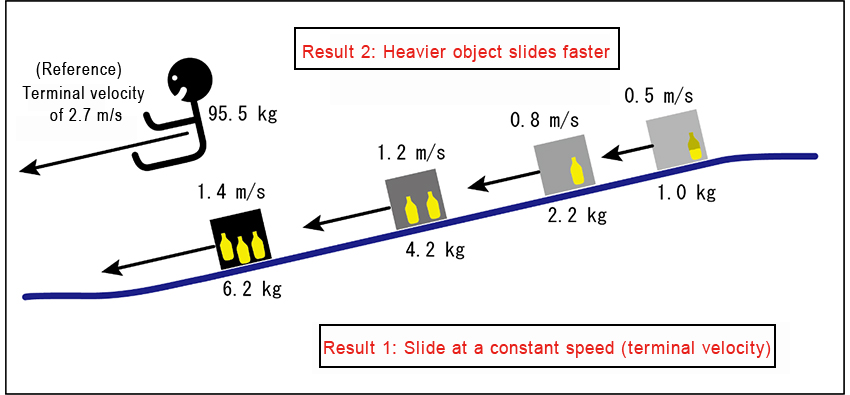Jun 06, 2023PRESS RELEASE
Do adults really slide down faster?: An undergraduate clarifies a playground mystery
Keyword:RESEARCH
OBJECTIVE.
Professor Jiro Murata of Rikkyo University’s College of Science and undergraduate student Masaki Shioda have jointly studied and clarified the question of “Why do heavier people slide faster on a playground slide?” This may seem self-explanatory, but is in fact a mystery from the viewpoint of physics. Shioda, a fourth-year student when the study was conducted, wrote his graduation thesis on the subject.
Shioda and Murata conducted an experiment by sliding objects of the same size but different masses on a playground slide, and carefully observed their motion. The team achieved high observation accuracy by using image-processing displacement measurement technology. They found that each object reaches a terminal velocity and then slides at a constant speed, and that the terminal velocity is greater for heavier objects. This characteristic was seen only with a roller-type slide, not with a metal plate-type slide when observed with the same degree of observation accuracy. The results show that if this phenomenon is treated as a matter of kinetic friction in mechanics, the coefficient of kinetic friction, which we were taught is a constant, is actually velocity- and mass-dependent to a large degree.
The results of their study were published in the June 6, 2023, issue of Journal of The Physics Education Society of Japan.
Outlines of research

Figure 1. Universality of free fall: Heavy and light objects fall with the same acceleration. This is because both the magnitude of inertia and the force of gravity are proportional to mass. When sliding down a frictional slope, the force of friction is also proportional to mass, so they theoretically slide with the same acceleration.
When Murata became aware of this mystery, he was preparing for the publication on his study results on why curling stones curl[1]. He solved that problem by discovering that the coefficient of kinetic friction between the ice and the curling stone is not constant, but varies depending on velocity. He thought that the slide-related mystery was similar, and began a joint study with Shioda, who had become interested in this phenomenon, as Shioda’s graduation research project. After making many trials, Shioda finally developed a method for accurately observing the motion of an object. He also conducted a series of research activities, such as evaluating measurement errors in the obtained data, and formulating and verifying theoretical models, as part of his graduation research project. In its final stage, Murata and Shioda conducted an observation in a playground near the university, using a set of observation equipment that addressed the issues involved.
They used a cardboard box as the observation object and recorded its motion on a playground slide with camera. The object had lights attached to it. The observation was conducted at night so that the lights would better stand out, and also to avoid disturbing children’s playtime. To prevent confusion over experimental conditions related to the size and mass, they placed different numbers of water-filled plastic bottles in the same cardboard box to see whether the speed was mass-dependent. Some of the results were unexpected.
First, the team found out that the box reached a constant speed on a slide, that is, a terminal velocity, and continued sliding at that speed, which was contrary to their assumption that an object continues accelerating when moving down a slide. This phenomenon can be seen when the resistance against the motion’s direction becomes stronger with accelerating speed. This is similar to the phenomenon in which a light object such as a feather reaches a terminal velocity while falling due to achieving a balance between air resistance and the force of gravity. Second, the team also found that when the mass is larger, the terminal velocity is greater (Figure 2). In particular, they observed that the lightest object (one kg) slid down surprisingly slowly, as slow as a human’s walking speed. From the observation results, they obtained qualitative knowledge showing that 1) the resistance is an increasing function of velocity due to the existence of the terminal velocity; and 2) the terminal velocity is an increasing function of mass. Interpreting this data based on a normal framework of the force of friction on a slope, it can be understood that the coefficient of kinetic friction is both velocity-dependent and mass-dependent.

Figure 2. Results obtained in this study. Each object speed reached a terminal velocity, and heavier objects slide faster. The number “95.5 kg” refers to the weight of a human holding a heavy object in his arms when sliding down. (see photo in Figure 3).

Figure 3. Shioda slides down holding a weight in his arms on the measurement day. The total weight was 95.5 kg, obtaining a terminal velocity (maximum velocity) of 2.7 m/s.
In an everyday sense, it is normal for any traveling object to eventually come to a stop. In physics, it is considered natural for an object to maintain its state of motion according to the law of inertia. When an object collides with another object, its state of motion changes, but the total amount of energy, including that of the other object, is conserved. Friction and air resistance, which are seen in everyday life, are treated as non-conservative forces whose kinetic energy is reduced, not conserved. This is a multibody problem that is theoretically almost impossible to solve because so many objects are involved as collision targets. But it is basically assumed that the total amount of energy is conserved.
While energy seems to dissipate and disappear among unnoticeably small and numerous collision targets, the force of friction can be an effective formula for averaging and simplifying the collision matter as an energy-absorbing environment.
A formula using the force of friction, which can comprehensively handle motion on slides with the coefficient of kinetic friction, which is a single variable, is a very effective approach in terms of information reduction. It is a coarse-graining operation that is similar to the idea that the macrostate of a gas composed of the same number of molecules as the Avogadro number can be represented by a small number of variables, such as temperature. Even in experiments in particle physics that involve extremely rigid physical laws, energy loss, which is a kind of coefficient of kinetic friction, that is caused when an observation target’s radiation travels through a material is frequently used as a main factor in measurement principles. While these approaches are very useful, we should also be conscious that they are a product of an artificial perspective for separating an object of interest being individually tracked for its motion in its surrounding environment, which involves many factors.
Although Shioda did not go into the components of the coefficient of kinetic friction in his graduation research project, the next step will likely be to infer, based on the characteristic of the obtained coefficient of kinetic friction, the process of energy dissipation, which is difficult to examine directly. In this study, the main topics of interest are thought to be the braking by bearings and the rotating motion of rollers. Coincidentally, a question involving how to think about similar things based on information related to the terminal velocity of an object that falls under air resistance was included in the National Center for University Entrance Examinations held in January 2023. However, deliberations on these matters may not be so simple, as there are multiple materials available for rollers, such as stainless steel, aluminum and resin. This results in a diversity of playground slides, such as their bearing lubrication conditions.
Based on Shioda’s graduation thesis[2], Murata published an article with Shioda as co-author to report part of their joint research in the Journal of The Physics Education Society of Japan as a good example of inquiry-based learning. The preprint on the study was also published and has received an unusually positive reaction for an academic paper, having been downloaded more than 8,000 times so far. Murata believes the project has stirred up intellectual curiosity among people who have questions about this subject, including those who wonder why objects such as ski plates and bicycles move faster because they are heavier, and teachers who see this phenomenon as something as mysterious and attractive as an exhibit at a science museum. Publishing the article in Japanese may have been another contributing factor, Murata says.
Rikkyo University Press Release, Sept. 5, 2022
https://english.rikkyo.ac.jp/news/2022/dn4ddm0000005cta.html
[2] Masaki Shioda: “Why do heavier people slide faster down playground slides?” Rikkyo University, graduation thesis, 2021 academic year
Article information
- Title: Experimental study of the dynamic friction coefficient of a slide
- Authors: Jiro Murata and Masaki Shioda
- Journal: Journal of The Physics Education Society of Japan Vol. 71, No. 2, 95 (2023)
- DOI: https://doi.org/10.20653/pesj.71.2_95
- Preprint: https://doi.org/10.51094/jxiv.236